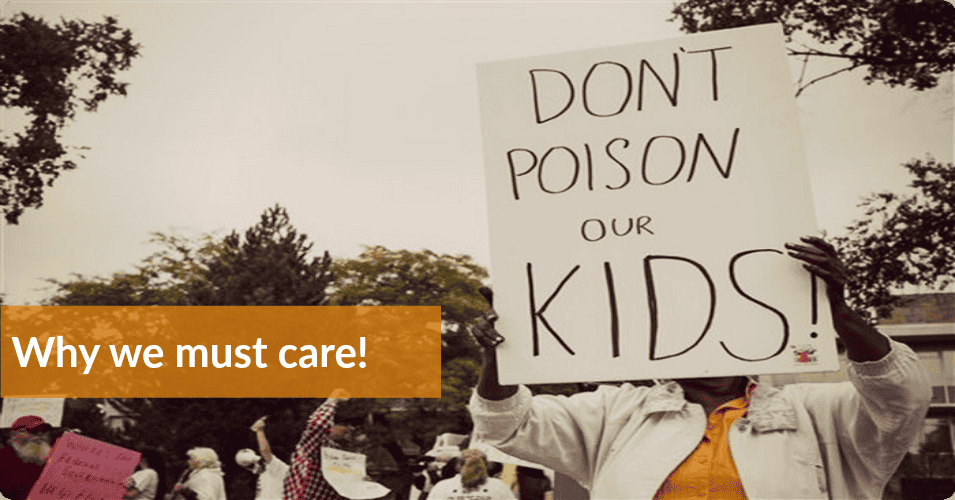Project managers often confront difficult choices. For example, how often do you face the conundrum of “getting it done” versus “doing it right”, “doing the easy thing” versus “tackling the root cause”, “toss it over the fence” versus “thinking holistically”, or “should the status health be Yellow or Red”? If you find yourself plagued and even tortured by finding the best options when facing these difficulties and trade-off decisions, then congratulations and welcome to our profession. My experience shows that while these can be painful problems, they are generally good and healthy signs that you care. Because the alternative, apathy, is far more consequential and sometimes comes with disastrous results.
“The Poisoning of An American City”, boldly printed on the front cover of the February 1st 2016 issue of Time magazine, reminds us of the danger of apathy. While this story has been front page news since late Fall, this declaration brings new clarity to the extent of failure at all levels of government and non-government organizations involved in the worst human created disaster in recent memory. How could something like this happen anywhere in the world (assuming a benign government with good intentions of serving its people), especially in a well-developed nation like the United States? As the story unfolds, the degree of failure at every level is just astonishing and appalling. The full analysis of what went wrong will take months to complete and even then, we may not know all the reasons and systemic failures. But in my mind, the predominant reason for this chain of systematic fiascos is a “lack of care”.
Administrators, professional engineers, and probably some project managers involved in transitioning the water source from the Detroit water supply to the Flint River likely made some bad choices along the way – getting the work done so the city can start saving money — so flip the switch as quickly as possible. It is hard to imagine that no one involved questioned the quality of water from Flint River, but doing the easy thing won out. The water supply was switched and the disaster unfolded.
I do not believe that the people involved in this catastrophe had malicious intent, at least at the onset. People on the Flint City Council, Dayne Walling (mayor at the time of switch), emergency manager (Ed Kurtz at that time), and many others including the engineers and operators probably felt that they were “doing their best” to save Flint money. Likely, most of these people were acting with the best of intentions. But given this magnitude of problem and the history of pollution of the Flint River, perhaps the many concerned individuals either maintained their silence or it was squashed by the higher ups. When the problems were first reported, the government went through what I consider to be the classic five levels of governmental incompetence:
1. Deny – The sample must be wrong. The sample size is too small. Did the sample come from water running after a few minutes (which of course reduces the amount of lead)?
2. Cover up – Michigan officials knew as early as the Summer of 2014 that something was wrong. Yet, the government stonewalled and withheld the information from public.
3. Falsify – As the situation got worse, officials started to change the process of water sampling and selective publishing data in favor of their position, further delaying actions.
4. Deflect blame – When the situation finally broke out into the public view late in the Fall of 2015, nearly everyone accused everyone else. Fingers pointed all direction except at oneself.
5. Accept – Finally when the implications of lead poisoning was clear to the nation, the government finally acted and declared a state of emergency on January 5th. It’s too late for the 100,000 Flint residents and the many more visitors to that city.
What’s worse, it is heart breaking reading the story especially when a simply solution of adding anti-corrosives costing the city of only $80-$100 per day can greatly reduce the amount of lead in water. Yet, it was not done due to a variety of reasons such as bureaucracy. Ultimately, this is institutional apathy at the worst. The civil servants and others involved in this entire chain of activities worried more about their bureaucratic processes, politics, and perhaps cost savings. They forgot their ultimate responsibility, which is to provide safe drinking water to their citizens. Without courageous people such as Dr. Mona Hanna-Attisha, the pediatrician who raised the issue into the public view, the crisis may have gone on for much longer.
Why is this relevant to project managers? Simple. As project managers, we have a “duty of care” to our stakeholders, especially to our customers and ultimate users. Managing scope, schedule, cost, and the many other factors and project management processes are important. But none is more important than caring about the project and who we ultimately serve. Sometimes project managers can overly rely on the project management processes, tools, and templates. But we should question if they are servicing the ultimate purpose of delivering the benefits. So the next time you are confronting difficult choices and having sleepless nights, pat yourself on the back. Because if you did not care, you would sleep quite soundly through that good night.

